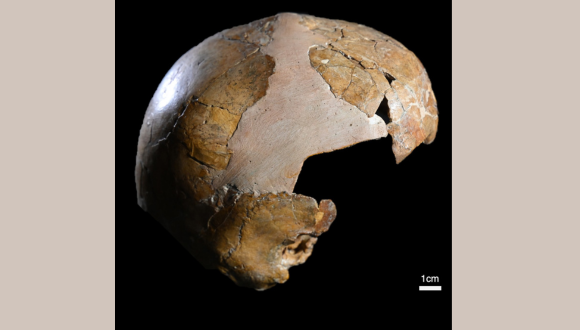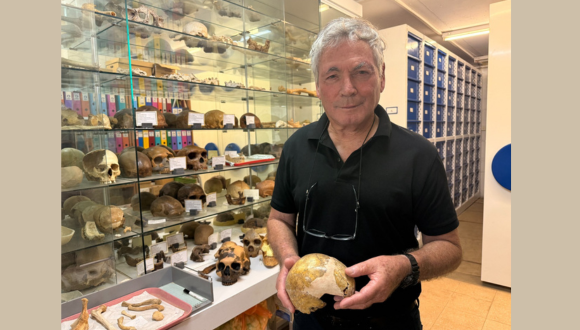 https://www.freunde-tau.org/wp-content/uploads/AI-reconstruction-of-mixed-Neanderthal-Homo-sapiens-family-580.jpeg
https://www.freunde-tau.org/wp-content/uploads/AI-reconstruction-of-mixed-Neanderthal-Homo-sapiens-family-580.jpeg
A TAU-led international study reveals the world’s oldest human fossil showing traits of both Neanderthals and Homo sapiens — a five-year-old child who lived 140,000 years ago in Mount Carmel’s Skhul Cave.
An international study led by researchers from Tel Aviv University and the French National Centre for Scientific Research provides the first scientific evidence that Neanderthals and Homo sapiens had biological and social relations, and even interbred for the first time, in the Land of Israel. The research team identified combination of Neanderthal and Homo sapiens traits in the skeleton of a five-year-old child discovered about 90 years ago in the Skhul Cave on Mount Carmel. The fossil, estimated to be about 140,000 years old, is the earliest human fossil in the world to display features of both groups, which until recently were considered two separate species.
A Window into Human Evolution
The study was led by Prof. Israel Hershkovitz of the Gray Faculty of Medical and Health Sciences at Tel Aviv University and Anne Dambricourt-Malassé of the French National Centre for Scientific Research. The findings of this historic discovery were published in the journal l’Anthropologie.
“Genetic studies over the past decade have shown that these two groups exchanged genes,” explains Prof. Hershkovitz. “Even today, 40,000 years after the last Neanderthals disappeared, part of our genome—2 to 6 percent—is of Neanderthal origin. But these gene exchanges took place much later, between 60,000 to 40,000 years ago. Here, we are dealing with a human fossil that is 140,000 years old. In our study, we show that the child’s skull, which in its overall shape resembles that of Homo sapiens—especially in the curvature of the skull vault—has an intracranial blood supply system, a lower jaw, and an inner ear structure typical of Neanderthals.”

The skull of Skhul I child showing cranial curvature typical of Homo sapiens
Rewriting the Timeline
For years, Neanderthals were thought to be a group that evolved in Europe, migrating to the Land of Israel only about 70,000 years ago, following the advance of European glaciers. In a groundbreaking 2021 study published in the prestigious journal Science, Prof. Hershkovitz and his colleagues showed that early Neanderthals lived in the Land of Israel as early as 400,000 years ago. This human type, which Prof. Hershkovitz called “Nesher Ramla Homo” (after the archaeological site near the Nesher Ramla factory where it was found), encountered Homo sapiens groups that began leaving Africa about 200,000 years ago—and, according to the current study’s findings, interbred with them. The child from the Skhul Cave is the earliest fossil evidence in the world of the social and biological ties forged between these two populations over thousands of years. The local Neanderthals eventually disappeared when they were absorbed into the Homo sapiens population, much like the later European Neanderthals.

The lower jaw of Skhul I child showing features characteristics of Neanderthals
Advanced Analysis Confirms Hybrid Traits
The researchers reached these conclusions after conducting a series of advanced tests on the fossil. First, they scanned the skull and jaw using micro-CT technology at the Shmunis Family Anthropology Institute at Tel Aviv University, creating an accurate three-dimensional model from the scans. This enabled them to perform a complex morphological analysis of the anatomical structures (including non-visible structures such as the inner ear) and compare them to various hominid populations. To study the structure of the blood vessels surrounding the brain, they also created an accurate 3D reconstruction of the inside of the skull.
“The fossil we studied is the earliest known physical evidence of mating between Neanderthals and Homo sapiens,” says Prof. Hershkovitz. “In 1998, a skeleton of a child was discovered in Portugal that showed traits of both of these human groups. But that skeleton, nicknamed the ‘Lapedo Valley Child,’ dates back to 28,000 years ago—more than 100,000 years after the Skhul child. Traditionally, anthropologists have attributed the fossils discovered in the Skhul Cave, along with fossils from the Qafzeh Cave near Nazareth, to an early group of Homo sapiens. The current study reveals that at least some of the fossils from the Skhul Cave are the result of continuous genetic infiltration from the local—and older—Neanderthal population into the Homo sapiens population.”

Prof. Israel Hershkovitz